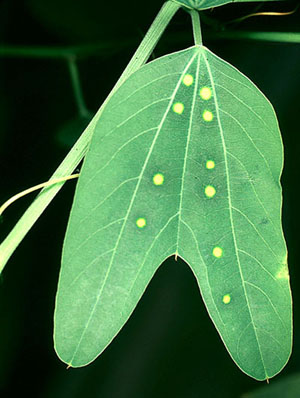The Passiflora genus is comprised of about 400 species of tendril-bearing, herbaceous vines commonly called passion-flowers. Some are important as ornamentals; others are grown for their edible fruits (Encyclopaedia Britannica, 2015; Yockteng et al., 2011). Many species of passion-flower are of particular interest to scientists studying coevolution and parasite-host interactions (Williams and Gilbert, 1981). These interactions are particularly complex between certain passion-flower species and Heliconiine butterflies.
It is suspected that Heliconiine butterflies have been coevolving with Passiflora for a long time (Gilbert, 1982). Heliconiine butterflies deposit their eggs only on Passiflora vines, where the eggs hatch into larvae that feed voraciously on the leaves of the vine. It’s known that Passiflora plants evolved chemical defences against herbivory by Heliconiine butterflies and other insect herbivores (Williams and Gilbert, 1981). While these defences are effective against its other herbivorous attackers, the Heliconiine butterflies have evolved the ability to circumvent these defenses. The remarkable thing is that some species of the vine now have features that appear to mimic the distinctive bright yellow eggs of the butterflies (Gilbert, 1982). Studies have shown that passion-flower plants that present bright yellow formations on the cuticle of the leaves are likely to deter actual oviposition by Heliconiine (Williams and Gilbert, 1981).
 |
| Egg mimic on passion-flower leaf. |
It is believed that the morphological development of these yellow spots on the cuticle is the current and ongoing step in the coevolution between these two actors (Williams and Gilbert, 1981).The question of how any one trait of a plant could be causally attributed to natural selection imposed by one species or genus of insects among so many has been investigated in depth for the passion-flower-Heliconiine relationship. With only a few major herbivores such as Heliconiine to account for, interpreting the defensive traits of passion-flower vines is relatively free of ambiguity (Gilbert, 1982). Although not all species that interact with Heliconiine have developed this morphological trait, the hypothesis is that this trait will be developed in the near future, as this coevolutionary step is still in progress (Williams and Gilbert, 1981; Gilbert, 1982). For this reason, these relationships are of particular interest to ecologists and evolutionary biologists. In the far future, who knows how the Heliconiine butterflies will circumvent this new defensive tactic?
References
Encyclopaedia Britannica, 2015, passion-flower, Encyclopaedia Britannica. Retrieved on 14, April, 2015 from http://www.britannica.com/passion-flower
Gilbert, LE, 1982, The Coevolution of a Butterfly and a Vine, Scientific American, vol. 247, pp. 110-121. Retrieved 14, April, 2015 from http://imap.passionflow.co.uk/downloads/gilbert
William, KS and Gilbert, LE, 1981, Insects as Selective Agents on Plant Vegetative Morphology: Egg Mimicry Reduces Egg Laying by Butterflies, Science, vol. 212, no. 4493, pp. 467-469. Retrieved 14, April, 2015 from http://www.jstor.org/stable/1686077
Yockteng, R, d'Eeckenbrugge, GC, and Souza-Chies, TT, 2011, Wild Crop Relatives: Genomic and Breeding Resources, pp. 129-171.
Photos
Helliconiine retrieved from Heliconius Butterfly Works.
Passiflora retrieved from Grassy Knoll Exotic Plants.
Egg Mimic photo by Lawrence Gilbert.
References
Encyclopaedia Britannica, 2015, passion-flower, Encyclopaedia Britannica. Retrieved on 14, April, 2015 from http://www.britannica.com/passion-flower
Gilbert, LE, 1982, The Coevolution of a Butterfly and a Vine, Scientific American, vol. 247, pp. 110-121. Retrieved 14, April, 2015 from http://imap.passionflow.co.uk/downloads/gilbert
William, KS and Gilbert, LE, 1981, Insects as Selective Agents on Plant Vegetative Morphology: Egg Mimicry Reduces Egg Laying by Butterflies, Science, vol. 212, no. 4493, pp. 467-469. Retrieved 14, April, 2015 from http://www.jstor.org/stable/1686077
Yockteng, R, d'Eeckenbrugge, GC, and Souza-Chies, TT, 2011, Wild Crop Relatives: Genomic and Breeding Resources, pp. 129-171.
Photos
Helliconiine retrieved from Heliconius Butterfly Works.
Passiflora retrieved from Grassy Knoll Exotic Plants.
Egg Mimic photo by Lawrence Gilbert.

Coevolution suggests co-adaptation of gene complexes in both species. Is this evident in Heliconius and Passiflora? You mention that not all species interacting with Heliconius have developed this type of mimicry but it is hypothesised that this could be developed in the future. But what about the trade-offs that might occur as a consequence? What about the pressures exerted by other predators?
ReplyDeletei DON'T KNOW
DeleteSo as I have read, it seems that there are different types of relationships between Heliconius and passiflora. 1) Those Heliconius that select a species of passiflora and can only grow on the selected species, those who are selective and can really feed on any passiflora, and those who are non passiflora selective and can grow everywhere.
ReplyDeleteThose who have selected the species of passiflora and can only live there, have passed the trade off. What types of passiflora are being selected and why?
ReplyDeletelol this was in my science paper question
ReplyDelete: How does having yellow spots benefit the plant?
my ANS:HUH
but after reading this, i understand now, Thanks!